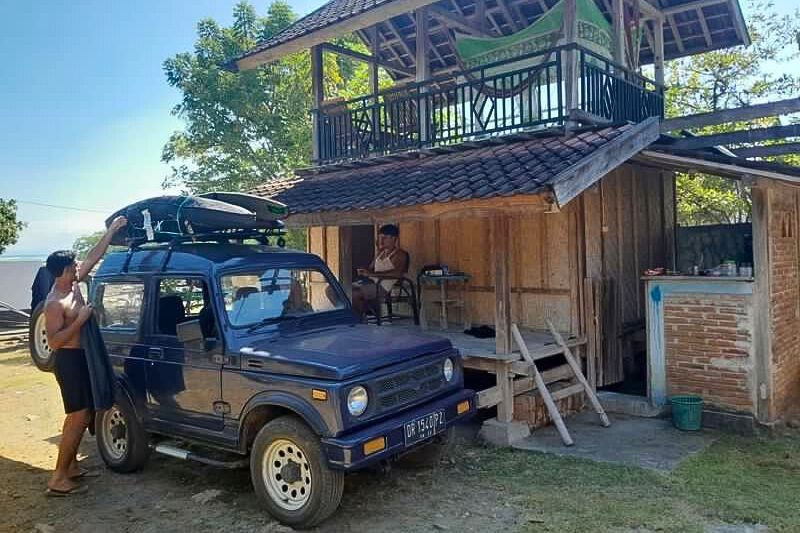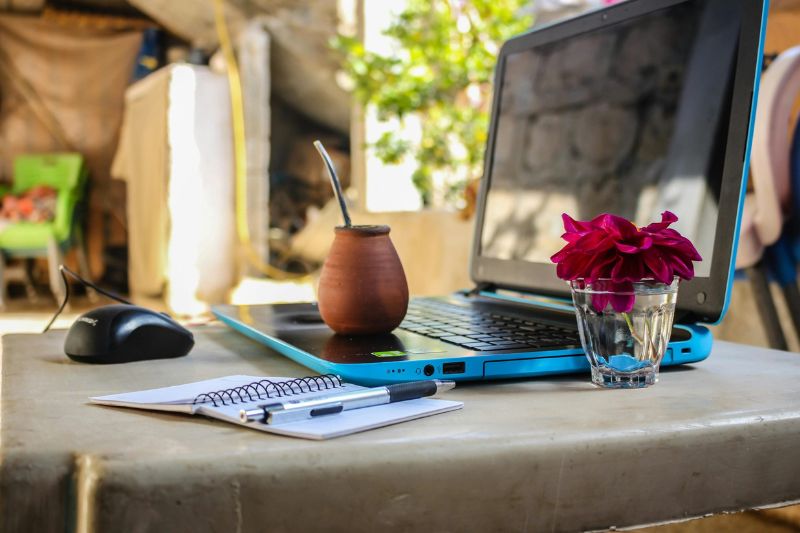Chasing waves across borders: This is the life of a digital nomad surfer. Enriching, exciting, but often exhausting. Especially when you have to lug around not only your entire workspace, but also your luggage, AND surfboards.
It’s a lot of time spent dealing with bubble wrap and flight regulations than what most people talk about. Oftentimes, this can be avoided or curbed with just a little bit of extra knowledge on practical packing, travelling, storing, and dealing with mishaps. Read on to unlock these secrets!
Packing Like a Pro: Protecting Your Surfboard for Air Travel
As a remote worker, I’m sure you understand first-hand the care and preparation that goes into properly packing your work equipment for travel between tropical surf havens. As work is an extension of your digital nomad lifestyle, your surfboards are the equivalent of your commitment as a surfer.
The Best Board Bag for Long Term Surf Travel

The first thing to note when preparing to explore the next destination is choosing the right board bag. Pick one that fits the number of boards you want to bring, features reinforced rail protection, and includes padding compartments.
If you’re travelling with multiple boards, and know you’re going to be walking lots, a board bag with wheels could be a great option for you. Keep in mind that these normally still require two hands to hold the non-wheeled front end of, which could be a challenge if you have a second piece of luggage. Otherwise, stacking board bags vertically on airport trolleys works just as well and saves tons of effort.
->Tip: If you’re travelling with a single board, it might be beneficial to do the exact opposite. Meaning, use a lighter board bag without wheels, and invest in a larger suitcase that can roll around with all your personal items. Either way, making use of trolleys will save you a lot of effort as you move through airports!
Packing Tips for Nomadic Surfers
If your boards are your babies, then always go for the extra padding! You never know who might be throwing your board around during travel (unfortunately). This may include pipe insulation or pool noodles for extra rail protection, and bubble wrap and cardboard for light security.
ALWAYS remove fins when packing surfboards, and try your best to use the straps (if there are any) to reduce excess movement in the board bag.
-> Tip: It is perfectly safe to add all SOFT items to your board bag as extra padding around the nose, tail, and rails. Avoid items that have large buttons, zips, or anything solid that could potentially cause minor dings due to extended pressure. Doing this can also reduce the size of your backpack or suitcase as your board bag would act as both board storage and personal luggage. Beware of the baggage weight if you choose to do this!
Check-in & Surfboards: What to Expect From Airlines
The BIGGEST and most annoying issue when checking in surfboards for flights is finding out that you have to pay extra to get them on the plane. Always try your best to check airline regulations on surf equipment (usually under the “additional sports equipment” tab) before booking your flights.
Some well-known airlines that are surf-friendly and accept surfboards (pending size) as part of your free checked baggage allowance include Singapore Airlines, Qantas, and Garuda Indonesia.
->Longboarding tip: Some airlines will decline to checking-in longboards because of their size, despite allowing shortboards through. If you’re a longboarding digital nomad on the road, make SURE to check airline regulations before booking flights!

When discovering remote surf towns and flying to lesser-known destinations, smaller airlines are usually the only option, and more often than not, these airlines will not have clear information on their websites for surfboard regulations. Hence, it is beneficial to always carry cash on you when heading to the airport in order to efficiently deal with extra and unexpected check-in costs.
Travelling frequently with surfboards in Indonesia as a digital nomad, I have unexpectedly had to pay anywhere between $US 12 to $US 60 (per board per flight) at the check-in counter. Prices are generally based on the size of the plane and the travel destination. This adds up fast with layovers and more boards.
->Tip: If you’re travelling to an extremely remote surf spot that is off the beaten track, aim to check in at the airport as early as possible. Some smaller planes (rows of 4 seats) have limited baggage space when it comes to surfboards. Checking in early can ensure your board arrives on the same flight as you and streamline your travel!
From Baggage Claim to Board Repair: Your Travel-Day Survival Guide
How to Handle a Broken Board During Travel
Arriving with broken surfboards can be heartbreaking!
Thus, if you have time, always aim to check the state of your boards as soon as you pull them from the conveyor belt at the baggage claim.
With luck and good surfboard packing, your boards should be fine. In the case that they are not, filing a claim with the airlines as soon as possible is vital to receiving adequate compensation for the damage. Do it at the airport, and take photos immediately for evidence.
When dealing with small damages, it is super useful to travel with a quick-fix repair kit, especially when in remote locations and secret surf spots.
This kit includes Solarez (UV curing resin), sandpaper, and ding tape. The tape is a temporary hold, and the Solarez is a temporary fix until you can bring your board to a professional ding repair. Click here for a short tutorial on how to quickly use Solarez to fix dings when you’re on the road.

If you’re in a surf town, ask locals or surf hostels for their best recommended ding repair shops. There is usually a local favourite that proves to be worth your time and money!
What to do if your Surfboard is Lost in Air Travel
If you’re dealing with a lost board bag, report the loss immediately at the airport.
Remember to save boarding passes and bag tags, as these items will assist you when filing the report with the airlines. If you’re in a remote surf town, consistently follow up with the airlines and be persistent but polite in reminding them to deliver your lost boards.
Additionally, check your insurance coverage for lost baggage. Your travel insurance may cover delayed baggage and could reimburse you for rental or replacement gear. Take photos and keep receipts of these expenses to help you file an insurance claim.
Don’t let lost luggage ruin the trip!
You can still work remotely, and most likely, if you’re in a surf village, there are great rental boards available. Ask locals, surf hostels, or fellow digital nomad surfers for recommendations. Even if it’s not your perfect shape, you can still get wet and make the most of the waves while you wait for your boards to arrive!
->Tip: NEVER utilise the outer pockets of your board bag for valuables (ie, FINS). These pockets are easy to access, and I have experienced having fins stolen from these compartments. I have also heard countless stories of this happening to other surfers, so be careful with what you put in there if you’re not going to be with your board bag 100% of the way.
Nomad Problems: Where to Stash Your Surfboards Between Trips
If you’re a remote worker who has currently found a home base, or are looking to travel temporarily without your boards, then you might be curious to learn about surfboard storage!
In most places, you will be able to find rental storage options. It is also common to store surfboards with surf hostels in wave-rich locations such as Bali or Sri Lanka. Furthermore, you can always ask a fellow surfer, nomad, or local friend to store your boards with them while you are away on a different kind of adventure.
If you’re planning on leaving for the season or an extended period of time, there are a few practices that can make your life easier in the future.
This includes cleaning your boards and all your surf gear with fresh water, and drying them out completely before packing them away. Make sure to cover them in breathable material and store them in a dry and shaded area. Spaces that receive a lot of sunlight or get hot can cause wax to melt and deteriorate surfboards over time, while damp areas can cause mould to grow. Avoiding both of these inconveniences will make your return and unpacking experience more pleasant and smooth.
Bonus Tips for Long Term Surf and Remote Work Adventures

Multi-board travel quiver: If you’re going on a surf trip or moving to a new surf town as a remote worker, travelling with two boards is practical and efficient. This provides you with one board and one backup. Perfect for remote spots or breakage insurance. What is ideal, however, is to bring a three-board quiver (if you can carry it!). This includes one fun board for small waves, one step-up for bigger waves, and one all-rounder (good for most conditions) as a backup or a go-to for short missions to new spots.
Always consider your destination: This is crucial to making the most of the waves in your destination. For example, surfing perfect reef breaks in Indonesia requires you to have a very different quiver than surfing sandy bottom beach breaks on the East coast of Australia. A board that would excel in one type of wave does not necessarily do the same in another. If you have the means to research, choose, and be ready, why not do it?
Resort inquiries: If you’re going on a surf vacation to a resort in a remote location, it is likely that they will have boards on site for rent. This can save you from having to travel with your surfboards entirely! Places like Kandui Resort in the Mentawais have an entire selection of surfboards that can be rented. They even offer services where you can order custom surfboards to the resort prior to your arrival. Thus, you can arrive to fresh boards ready to be waxed, and all you have to do is bring them home after.
Keeping the Stoke Alive, Wherever You Land
Travelling with boards isn’t always easy, but the reward of surfing your dream wave with your own trusted quiver underfoot is often worth the hassle.
With a bit of smart packing, planning, and local knowledge, you can easily avoid the common travel bumps and pitfalls and make the most of your next surfing adventure!



